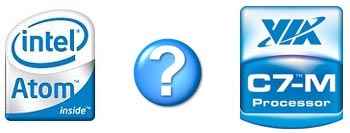You might be wondering why some UMPC's, most notably, HP's 2133 Mini-note uses a VIA processor. What's with VIA anyway? Is it the AMD processor equivalent for netbooks?

Just a brief background, When the Asus Eee PC came out, it used the Celeron M processor that runs at 900MHz. In response, VIA created the C7-M processor to grab some market at the so-called Netbook category and it had some success with Packard Bell, Maxdata, and Everex to name a few using it on their machines. The problem was, even at 1.2GHz ,VIA C7-M was not as fast as Intel's Celeron M and it runs even hotter.
Then Intel Atom came, which is much faster than VIA C7-M at 1.6GHz for netbooks. Not to mention being less energy-consuming which leads to a much cooler machine. Here are some numbers between the two for you geeks:
| Processor | VIA C7-M ULV | Intel Atom |
| Model | 772 | 230 |
| L2 Cache | 128KB | 512KB |
| Clock Speed | 1.2GHz | 1.6GHz |
| FSB | 400MHz | 544MHz |
| Thermal Design Power | 5w | 4w |
| Architecture (lower nm, less power consumption) | 90nm | 45nm |
So as of now if it were me, I would rather go for Intel Atom-based UMPC's instead of VIA even if VIA is much cheaper. However, VIA and Nvidia have joined forces to take on Intel in the chip-world of UMPC's and they'll be releasing VIA Isaiah soon which promises to be a big improvement from C7-M. So we'll see how the near future shapes up for the two.



0 comments
Post a Comment